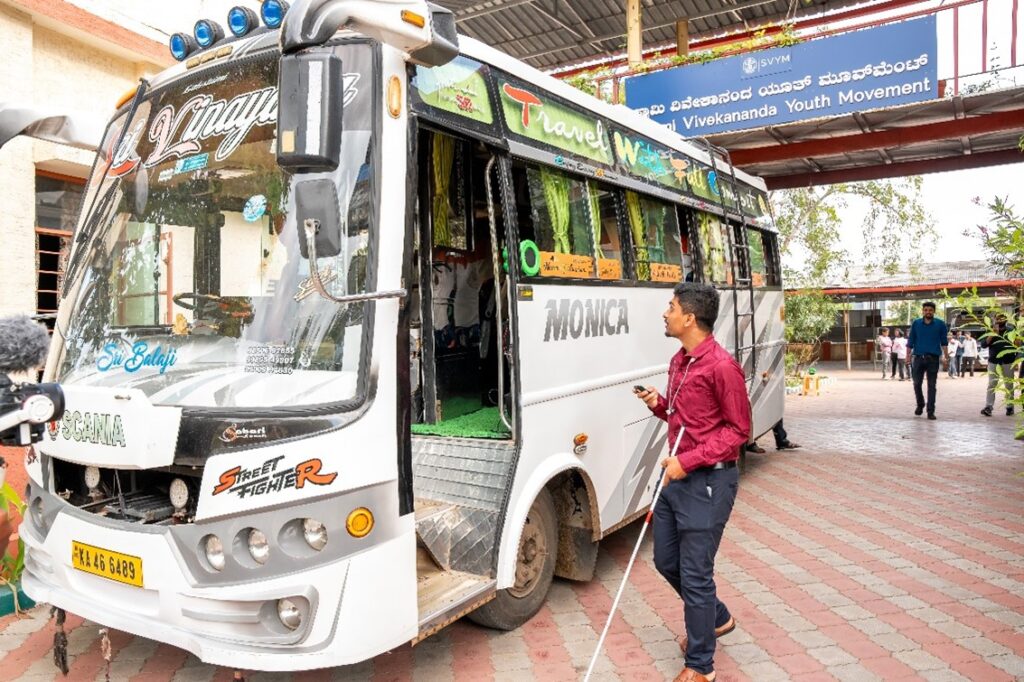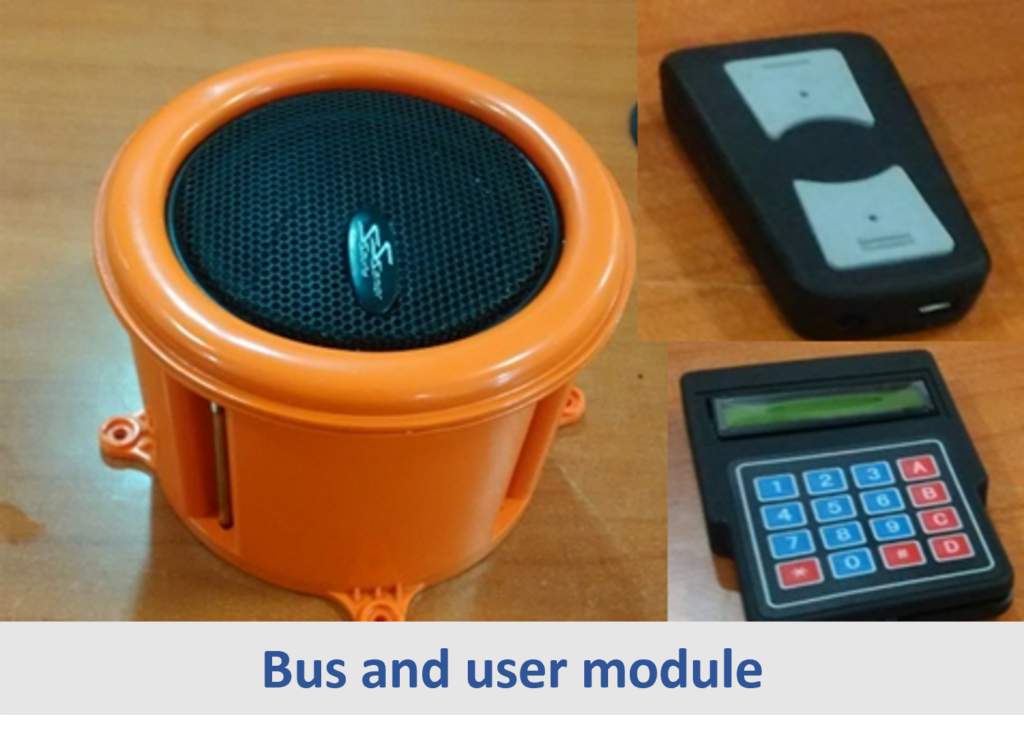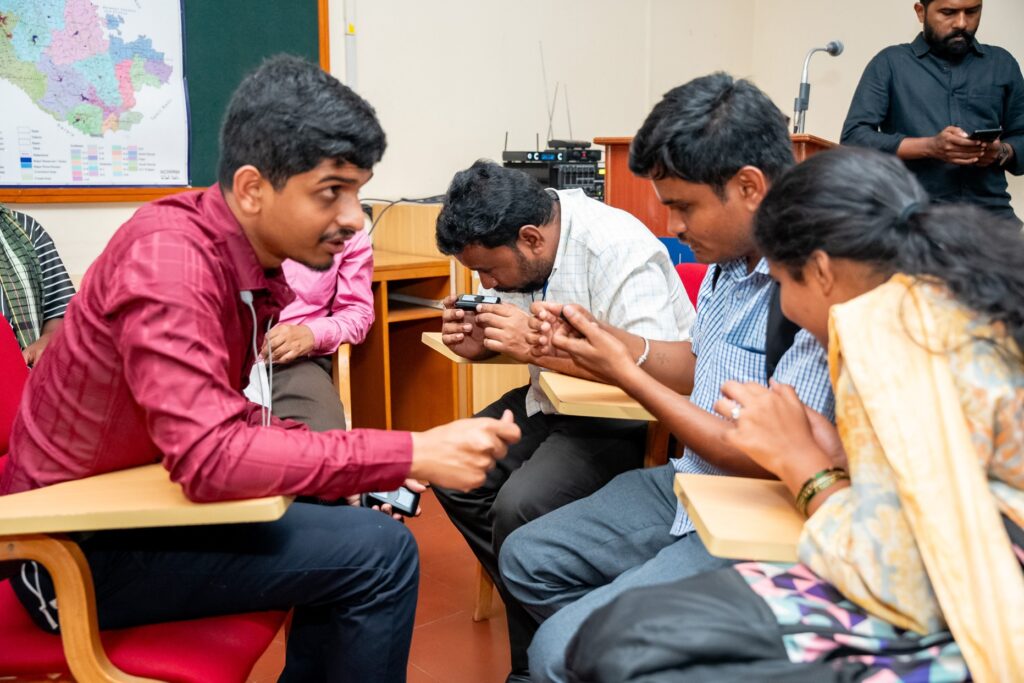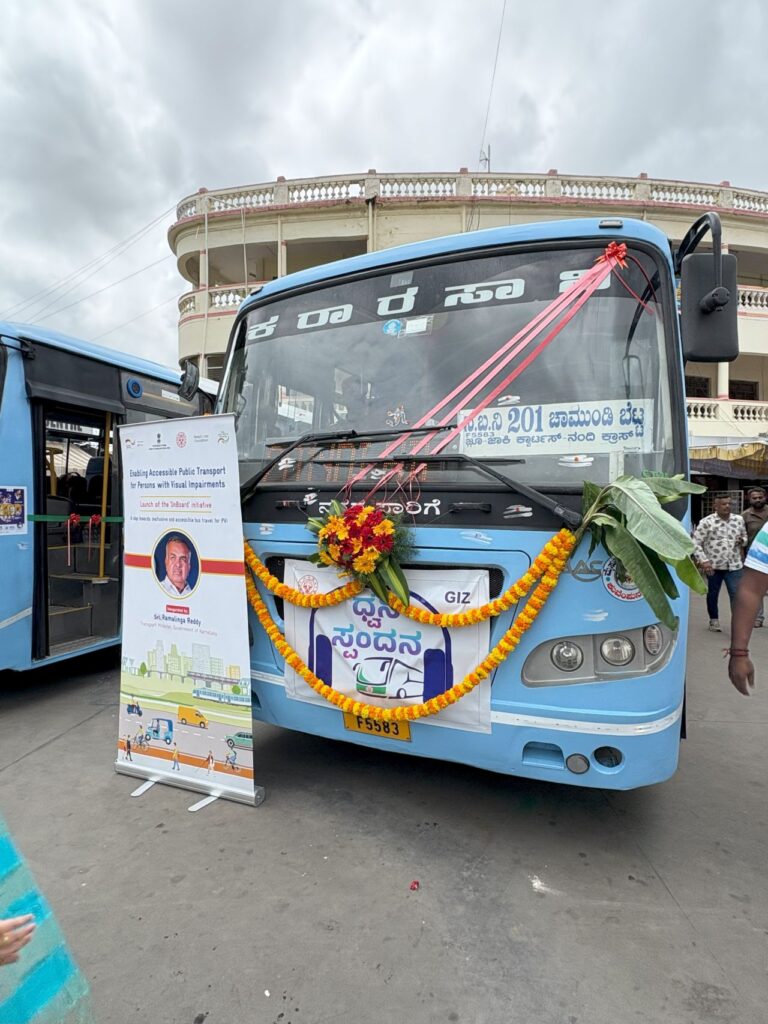
Earlier, I had to ask multiple people at the bus stop. Sometimes they would help, sometimes they wouldn’t. Now, with this device, I know exactly which bus is coming. I feel more confident traveling alone.
Gatak Singh, visually impaired resident of Mysuru
For years, visually impaired commuters across India have navigated city buses with uncertainty and dependence. In India, buses form the backbone of mobility for millions, yet for many people with visual impairments, they also represent a space of exclusion, where information gaps, physical barriers, and lack of awareness limit opportunities.
The OnBoard initiative, a user-friendly assistive technology developed by the Indian Institute of Technology (IIT Delhi), is changing this reality, one bus at a time. Implemented in partnership with GIZ India, the Directorate of Urban Land Transport (DULT), the Karnataka State Road Transport Corporation (KSRTC), and the Raised Lines Foundation (RLF), the project has introduced a simple but impactful technological innovation to Mysuru’s city bus service.
With the device now installed in 200 KSRTC buses and 400 visually impaired commuters trained, OnBoard has transformed Mysuru’s city buses into spaces of accessibility and inclusion, showcasing the power of collaboration.
But this story isn’t just about technology. It’s about the kind of cities we want to build, ones that see everyone.
For visually impaired commuters, the journey doesn’t begin when the bus moves; it begins with uncertainty at the bus stop. In Mysuru, as in most Indian cities, public buses do not audibly announce their route or destination. This leaves visually impaired passengers reliant on strangers to identify the corrrect bus, and even then they may need assistance boarding.
A survey conducted before the project showed that most visually impaired passengers depended entirely on others to identify buses, leading to missed appointments, anxiety, and reduced participation in daily urban life.
Although India’s Rights of Persons with Disabilities Act (2016) mandates accessibility, implementation on the ground often focuses on ramps and lifts, overlooking less visible but equally critical barriers, such as the absence of accessible communication in transport systems.
In short, the gap was not technological, it was social and systemic. Many of these patterns echo broader reflections emerging in the field, including in a recent illustrated brief by the Institute for Transportation and Development Policy (ITDP) and the Transformative Urban Mobility Initiative (TUMI), which underscores how everyday design choices can either open up or limit people’s ability to move through a city.
Mysuru, a city known for its inclusive civic ethos, was identified as a promising site to pilot a scalable assistive mobility intervention. But the challenges were clear: a lack of existing accessible technology in buses, limited awareness among transit operators, and the need for a solution that was both technically feasible and user-friendly. It began with a shared vision: to make Mysuru’s buses independently accessible to people with visual impairments.
Together, GIZ India, IIT Delhi, DULT, KSRTC, and RLF co-created a scalable solution: OnBoard, a low-cost assistive devic that bridges the gap between commuters and buses through simple, real-time communication. At its core, the system includes:

When a bus approaches, the user can query its route number; the device audibly announces the bus number, allowing the user to identify and board confidently. The project followed a structured implementation pathway:
A KSRTC representative reflected:
At first, we weren’t sure how it would work in our system. But once we saw how confident users became, we realized that this is the kind of change public transport needs.

Today, over 200 Mysuru city buses offer an accessible and dignified travel experience for visually impaired commuters. With 400 users trained to operate the OnBoard device, reliance on others for basic travel needs has significantly reduced, making independent mobility not only a fundamental right but a lived reality for many.
Preliminary feedback from surveys and field observations has been overwhelmingly positive: users reported reduced anxiety and dependence at bus stops, greater confidence in planning and completing trips, and increased use of public transport.
The initiative’s impact has also been recognized nationally. In November 2025, OnBoard received the Svayam Accessibility Award for “Redefining Public Transport for Persons with Disability” and the Urban Mobility India (UMI) Conference & Expo Running Trophy for “State/UT Implementing the Best Urban Transport Projects.” These awards highlight the effectiveness of inclusive, collaborative approaches and reinforce Mysuru as a model for accessible public transport across India.
Inspired by Mysuru’s success, the Bangalore Metropolitan Transport Corporation (BMTC) has begun scaling up the OnBoard system to 500 buses and 500 new users, a strong indicator of replication potential across other urban bus networks.
Beyond technology, OnBoard has ignited a shift in mindset: accessibility is not an optional feature, but a core element of sustainable, inclusive mobility.
Relatively simple technological interventions can bridge critical accessibility gaps in public transport, when paired with strong stakeholder alignment. The OnBoard project in Mysuru stands as a compelling example of inclusive innovation. But the real success lies not just in devices installed or commuters trained, it lies in the shift in mindset. Public transport is no longer just about moving people; it’s about including everyone in the city’s life.

The journey wasn’t without challenges. Customizing the technology, aligning multiple institutions, and ensuring user-friendly training demanded patience and adaptability. But these experiences yielded three key lessons:
A monitoring process is now underway to assess long-term impact and refine the solution. The project team is also developing a mobile app version of OnBoard, which will allow visually impaired commuters to connect directly to buses without needing separate hardware. Efforts are ongoing to integrate the system into India’s Urban Bus Specifications, ensuring that future buses are inclusive by design.
Yet much remains to be done. India’s cities must make accessibility a default feature, not a retrofit. OnBoard shows that with the right partnerships, even modest technologies can redefine what public transport stands for: autonomy, dignity, and equal access for all.
And it all begins with listening to voices like Gatak Singh’s, and building systems that respond. OnBoard has shown that accessibility is not an optional feature — it’s a right — and that small, carefully designed interventions can create ripple effects, inspiring cities across India to reimagine public transport as inclusive for all.
The Sustainable Urban Mobility – Air quality, Climate action, Accessibility (SUM-ACA) project is funded by the German Federal Ministry for Economic Cooperation and Development (BMZ) and implemented by Deutsche Gesellschaft für Internationale Zusammenarbeit (GIZ) GmbH.
If you believe that you suffer (potential) negative social and/or environmental consequences from IKI projects, or wish to report the improper use of funds, to voice complaints and seek redress, you can do so using the IKI Independent Complaint Mechanism.